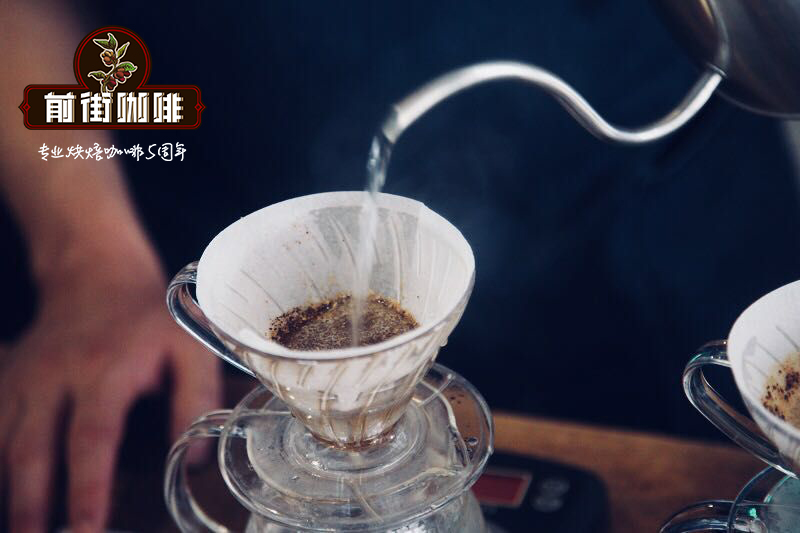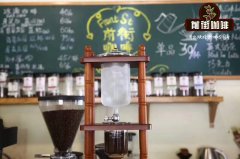Factors that affect the taste of coffee. What are the decisive factors that affect the taste of coffee?

Professional coffee knowledge exchange more coffee bean information please follow the coffee workshop (Wechat official account cafe_style)
60% of a good cup of coffee depends on the quality of raw beans. As a coffee practitioner, we should open up the pattern and learn more about the whole link of "From Seed To Cup" as much as possible. This is helpful to the link you are engaged in. After all, bakers bake according to beans, while baristas brew through beans and baking ideas. We know that scientists have extracted thousands of aromatic substances from raw coffee beans, and different coffees have different flavors and aromas. So what are the reasons that determine the difference in coffee?
I. different places of origin
Different producing areas will have different temperature, rainfall, sunshine, humidity and soil composition. So even the same variety of coffee will be cultivated in different environments with different flavors and aromas. For example, the rose summer in Ethiopia is different from that in Panama, because coffee trees produce fruits with different flavors depending on the growth environment. Generally speaking, African beans taste bright and cheerful, and the flavor in the mouth is changeable and lively; Central and South American beans are enthusiastic and unrestrained, with only a mouthful of all the flavors coming; Asian beans are relatively conservative and need to be extracted at high temperature for a long time. Figure it out slowly. I have to say, beans are like people.
Second, different varieties
Different places of production, even different estates, the varieties of coffee will be different, so the cultivated varieties of coffee are also very diverse, of course, the taste and aroma of coffee are also varied. There are thousands of coffee tree species all over the world, and the more common species are as follows:
Iron card species (Typica):
Have superior aroma and mild sour taste
Bourbon species (Bourbon)
The thickness, aroma and sweetness of the concentrated alcohol are very bright.
Kaddura species (Caturra):
Refreshing sour fruit, light sweetness.
Kadimo species (Catimor):
Bitter taste, dark chocolate aroma.
Canefra (Canefora):
Can also become Robusta, taste single, mugi-cha fragrance.
Third, different treatment methods
Coffee berries are processed after picking. Typical treatment methods are as follows:
One-day sun treatment (Natural)
2 washing method (Washed)
3 semi-washing method (Semi-washed)
4 Natural removal of pectin (Pulped Natural)
-Red honey (Red Honey)
-Yellow honey (Yellow Honey)
-Black honey (Black Honey)
Sweet & mellow thickness:
Sun exposure > natural pectin removal > semi-washing > water washing
Acidity & aroma:
Washing with water > semi-washing > natural removal of pectin > solarization
Solarization is the oldest treatment method, which is not only time-consuming, but also easy to produce defective beans. The water washing method is to make up for the defects of the sun method and was born. The washing method saves time, reduces the occurrence rate of defective beans, and then controls the quality of coffee. However, the flavor and alcohol thickness of coffee processed by washing method are not as good as those processed by tanning method. As a result, people invented honey treatment, that is, the natural removal of pectin, that is, the peel was removed and the pulp was preserved for drying.
Fourth, planting at different elevations
For people who grow fine coffee, in order to be similar to the acidity of fruit and have deep dry aroma of coffee, it is found that the area suitable for growing fine coffee is the plateau with an altitude of 1500 meters to 2000 meters above sea level. Because there is a large temperature difference between day and night, the amount of oxygen absorbed by plants increases and the coffee fruit shrinks more frequently. But there are exceptions to this fact. In the Kona region of Hawaii, coffee beans are grown at an altitude of about 700 to 1,100 meters, because Hawaii has a unique island climate, excellent sun conditions, and usually modern facilities. farmers are so rich that they all have feelings and integrity.
Fifth, regional coffee grade standards are different
Coffee grades from different places also have different classification criteria. Basically, there are four criteria for scoring raw coffee beans:
1. Planting altitude
2. Size of raw beans (sieve size Screen size)
3. Coffee bean flavor
4. Proportion of defective beans
But different countries have different benchmarks. In Brazil, for example, the criteria for taste are as follows (from high price to low price):
Strictly Soft > Soft > Softish > Hard > Hardish > Rioy > Rio
There are about four kinds of defective beans in coffee:
Over-fermented beans: spicy, astringent, sour and bitter.
Black beans: smelly and bitter.
Worm-eaten beans: smelly feet, rotting corpses.
Moldy beans: mildew, rot, bitterness.
6. The new and old degrees of raw beans are different
With the same kinds of beans, manors, elevations and planting methods, there is a great difference between new raw beans and old beans in dry and wet fragrance. Because coffee is also a kind of crop, freshness is very important to coffee.
The change of freshness of raw beans is as follows: new season beans > overgrown beans > old beans > aged beans.
Newly produced seasonal beans:
Raw beans harvested within a year
Overyielding seasonal beans:
More than one year
Lao Dou:
More than two years
Chen Niandou:
Ripe raw beans.
In terms of water content, the processed raw beans contain about 11-13% moisture. The longer the storage time is, the moisture will be gradually lost. For example, after a year at room temperature, the water content of raw beans will drop to less than 10%. The color of raw beans just processed is blue-green / green, but as time goes on, the color of raw beans will gradually become light green, white or yellow. And with the extension of raw frying, the aroma of raw beans will change from grass and spice to hay or rice, and for a longer time, it will be completely tasteless.
7. Different ways of preservation
No matter how good the quality of raw beans is, they will vary depending on the preservation methods and facilities. The ideal thing is to maintain an indoor temperature of 15,18 degrees Celsius and an indoor humidity of 50% and 60%. The wrong way of preservation will affect the flavor and aroma of beans, and even deteriorate. It often causes raw beans to fade and whiten and become wet and soft.
White or yellow raw beans:
Because the temperature in the storage place is too high or too dry, the moisture of raw beans will be sucked away by the air.
Raw beans with a moist surface:
The humidity of the storage place is too high, the rainy season. If the condition is serious, mold will appear on the surface of the beans.
I believe that many baristas have had a similar experience, recommending a cup of coffee that they like very much to consumers, but consumers frown after drinking it, or pay for it without saying a word. There have always been two voices in the coffee industry. Coffee makers think that they are professional, while consumers are ignorant and need to guide consumers, while others think that no matter a barista or a big shot in the coffee industry, how good it is, only when consumers say yes is really good, and it's all in vain.
But professional and tasty statements are too vague. For a cafe, how to monitor, adjust the quality of its products, create its own product characteristics, and communicate with consumers at the same time is the king. Next, let's get to the point and talk about what factors affect the consumer experience.
First, the extraction level and stability of coffee
For the broad masses of employees, what they are most concerned about must be how to improve their own level. How to improve their extraction technology, give consumers better service, and at the same time improve the stability of better products. This can not only increase the favor of consumers, but also improve their professional quality.
Although some people say that coffee is good enough, it does not conflict with whether the coffee is stable and whether the extraction is sufficient, because it is more of a choice of coffee, simply correcting the taste of coffee from extraction and looking for a stable way of extraction. it is better to directly select suitable and stable coffee beans, rely on proper baking, and better upgrade your professional skills.
Second, the choice of coffee products and the running-in of the baristas' ideas of the products.
A cafe's choice of products to a large extent reflects the attentiveness of shopkeepers and baristas. A reasonable coffee shop should have a variety of flavors and different roasting degrees of coffee, but this is not a small burden on the operating cost of the coffee shop.
At this time, the coffee shop can choose to put in a roaster at once for its own baking, or it can choose to rely on a variety of choices to attract consumers, or it can choose several fixed styles, and then put on one or two new products every quarter every month. But remember that the product should take into account the aesthetic and preferences of the public as much as possible.
Because the outside world's understanding of products and that of the industry are always slow, there will be many misunderstandings and rumors, but for a minority industry, there is always a lack of communication with the outside world. Although many baristas have obtained a lot of professional certificates, they are not very clear about the origin of the various flavors of coffee, but the practical information shared between the group and the official account often leads to differences with realistic consumer attitudes and customers. In the end, you still need to run-in with your own communication.
As a matter of fact, baristas should enhance their communication with customers while upgrading their profession, rather than allowing consumers to adapt to your practice.
Third, timely communication and follow-up and skills upgrading
When it comes to the communication between baristas and consumers, it actually involves two aspects. First, anticipation, familiarity with consumers' psychology and taste preferences, such as a consumer who is injured by smoking, will definitely like deep-baked Mantenin or American coffee. If you recommend a full flavor, sour Yejia or Kenya with a strong berry flavor at this time, it is certainly not a good choice.
If the barista should give an account in advance to consumers who are not familiar with the characteristics of the store, ask others about their daily preferences, such as their own Mantenin in the sun, or Sulawesi, which is sour, rather than a model with obvious mellow thickness, it is also necessary to inform consumers in time that it is not the taste of the impression, and do a good job of communication in order to better guide consumption.
After that, if the customer does not know the flavor after introducing the coffee to the consumer, or if he does not like certain flavors after drinking the coffee, he should follow up in time and ask whether it is because of the bad taste or the taste he does not like. This is also part of experience and communication. Although consumers are paramount and good to drink is the most important, the standard of the word "good" is too broad, so it cannot be summed up in a word.
Important Notice :
前街咖啡 FrontStreet Coffee has moved to new addredd:
FrontStreet Coffee Address: 315,Donghua East Road,GuangZhou
Tel:020 38364473
- Prev

Starbucks iced drop coffee. How to make iced coffee. How to make iced coffee.
Professional coffee knowledge exchange More coffee bean information Please pay attention to coffee workshop (Weixin Official Accounts cafe_style) Summer is coming. For coffee lovers, it is best to drink a cup of cold iced coffee. If you refuse high calories, pay attention to taste aftertaste and are willing to explore new tastes, you may wish to try Ice Drip Coffee, the goddess drink in the ice coffee world this summer.
- Next

What's the difference between latte, mocha and cappuccino? What latte tastes like.
Professional coffee knowledge exchange More coffee bean information Please pay attention to coffee workshop (Weixin Official Accounts cafe_style) Do you know the difference between Latte, Cappuccino and Mocha? Have you ever had a question when you opened the Menu in a cafe or stood at the ordering bar, but were afraid to ask it out loud?
Related
- Beginners will see the "Coffee pull flower" guide!
- What is the difference between ice blog purified milk and ordinary milk coffee?
- Why is the Philippines the largest producer of crops in Liberia?
- For coffee extraction, should the fine powder be retained?
- How does extracted espresso fill pressed powder? How much strength does it take to press the powder?
- How to make jasmine cold extract coffee? Is the jasmine + latte good?
- Will this little toy really make the coffee taste better? How does Lily Drip affect coffee extraction?
- Will the action of slapping the filter cup also affect coffee extraction?
- What's the difference between powder-to-water ratio and powder-to-liquid ratio?
- What is the Ethiopian local species? What does it have to do with Heirloom native species?

